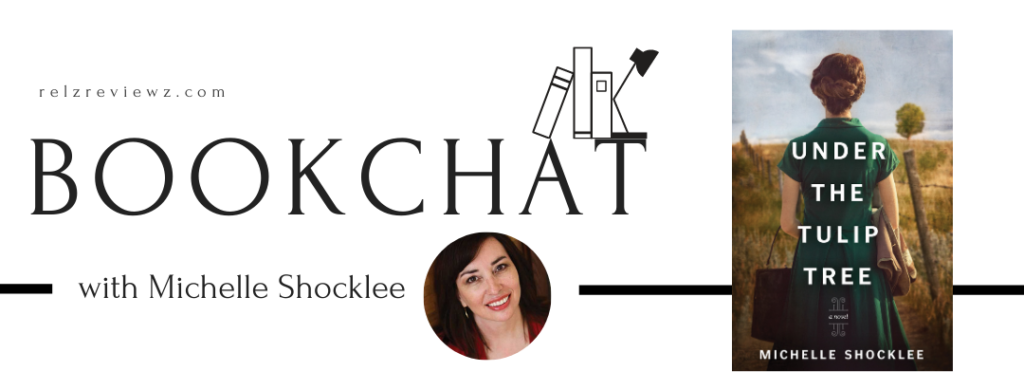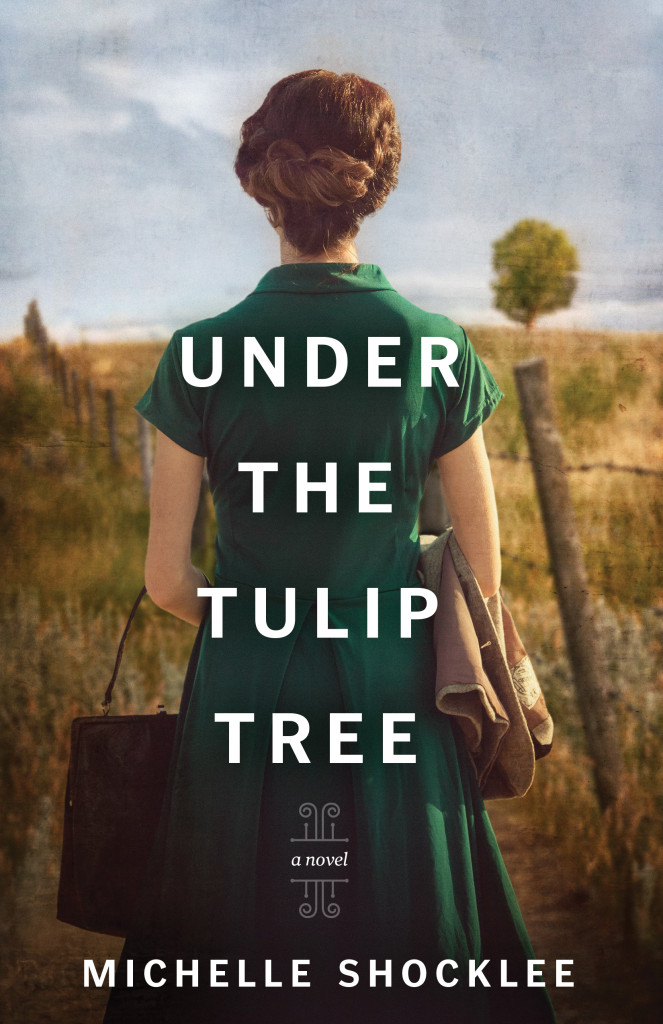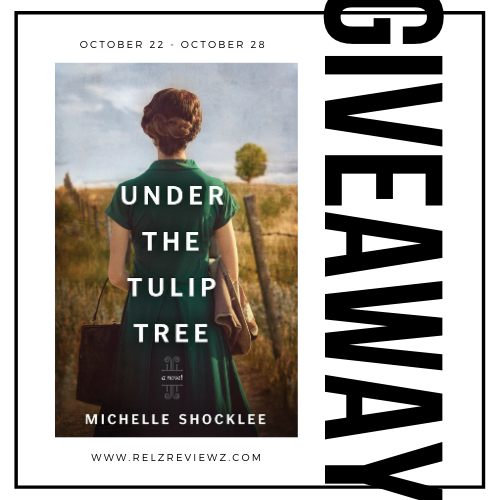
It’s a first time welcome to Michelle Shocklee here at Relz Reviewz to celebrate the release of her latest historical novel, Under the Tulip Tree, set in the 1930s against the backdrop of the Great Depression and history of slavery.
Publishers Weekly has this to say, “Shocklee elevates the redemptive power of remorse and the grace of forgiveness in this moving saga.
Enjoy the insights Michelle shares about her leading characters, the impact the Great Depression had on her parents, and what she learned from her intense research.
And with thanks to Tyndale House, we have a copy of Michelle’s book to giveaway – enter below!

Sixteen-year-old Lorena Leland’s dreams of a rich and fulfilling life as a writer are dashed when the stock market crashes in 1929. Seven years into the Great Depression, Rena’s banker father has retreated into the bottle, her sister is married to a lazy charlatan and gambler, and Rena is an unemployed newspaper reporter. Eager for any writing job, Rena accepts a position interviewing former slaves for the Federal Writers’ Project. There, she meets Frankie Washington, a 101-year-old woman whose honest yet tragic past captivates Rena.
As Frankie recounts her life as a slave, Rena is horrified to learn of all the older woman has endured―especially because Rena’s ancestors owned slaves. While Frankie’s story challenges Rena’s preconceptions about slavery, it also connects the two women whose lives are otherwise separated by age, race, and circumstances. But will this bond of respect, admiration, and friendship be broken by a revelation neither woman sees coming?
Bookchat with Michelle
Please share a little about your characters Rena and Frankie.
Rena is a young, naive dreamer. She grew up in a sheltered atmosphere, with parents who cared too much about money and the opinion of others. When their lives are turned upside down by the stock market crash of 1929, Rena is forced to see things in the world as they are, not as she’d simply believed them to be.
Despite Frankie’s advanced age of 101 years, she’s spry and spunky. She’s seen and done things people like Rena can’t imagine, yet she doesn’t wallow in the hard life she’s lived. She’s a no-nonsense kind of woman, but she’s also wise, considerate, and above all, faith-filled.
Describe your book in 5 adjectives.
Inspiring. Complex. Emotional. Realistic. Captivating.
Despite their disparity in age, race, and experiences, what do Rena and Frankie have in common?
Both Rena and Frankie ultimately want their lives to be meaningful. Although they’ll go about it in different ways, each will find her place in her community and in the world. Family is important to each of them. Through circumstances neither would have chosen, they each find love and purpose. Their unlikely friendship reveals that we don’t have to live the same type of life as another person in order to find commonalities that bring us together.
Was either woman inspired by a real person?
Neither character was inspired by a specific person, but their stories are based on the real people who worked for the Federal Writers’ Project and the brave former slaves who willingly shared their life’s story with strangers. I would not have been able to write Frankie’s story without the true narratives of former enslaved people collected in the 1930s. The word-for-word telling of life in bondage as seen in the slave narratives was invaluable to creating a true-to-life character.
What are the major themes in this story?
Truth, redemption, and forgiveness are at the heart of Under the Tulip Tree. As Rena discovers, it’s all too easy to believe lies. Lies about the stability of a nation, about her family, and even about herself. Frankie’s raw, gut-wrenching story forces Rena to reevaluate everything in her life. And that’s where redemption and forgiveness are found.

In writing about the Great Depression and the institution of slavery, what shocked or surprised you the most as you researched these things?
Both of my parents were children during the Great Depression, so I grew up hearing stories about the hardships endured during those difficult years. When my grandfather passed away in 1932 from tuberculosis when my dad was only 9 years old, my grandmother had to sell the family’s only car in order to buy a headstone. As I researched the Depression for the novel, I found similar stories of sacrifice and suffering over and over. Although our generation has experienced an economic depression, I don’t think we can understand how truly hard times were in the 1930s.
Researching slavery is painful. To read about the horrors suffered by those enslaved is disheartening. But it wasn’t until I discovered the slave narratives that I truly began to grasp how utterly dehumanizing the institution of slavery was. When you read a former slave’s own words describing what was done to them and how they were forced to live, it opens your eyes in a way a third-person narrative in a history book can never achieve.
Which character did you enjoy writing most? Which character gave you the most grief?
The answer to both of these questions is . . . Frankie. I love Frankie. She is probably my most favorite character out of all my books. During the course of writing Under the Tulip Tree, she became a real person in my heart and mind in a way no other character has ever done before. But writing her story in first person was incredibly challenging. Not only because she’s black and I’m not, but because I felt her character represented thousands upon thousands of former enslaved people. It was vital I get her story right. That’s where the slave narratives came in. Much of Frankie’s life came directly from the stories of real former slaves.
Given the difficult subject matter in this story, what was a light-hearted or fun moment you experienced while researching or writing Under the Tulip Tree?
Although the state tree of Tennessee is the tulip tree, or Tulip Poplar, I wasn’t familiar with it. While I was working on the book, a major storm knocked down a number of trees at the back of the property where my husband and I work as estate caretakers. When we drove out in the ATV to check things out, I was surprised and saddened to find one of the fallen trees was a tulip tree, full of the yellow tulip-shaped blossoms it’s named for. Of course, I had to climb up on it so hubby could take my picture. I was quite pleased to see that several other tulip trees nearby were unharmed by the storm.
Regarding race relations, what has changed since the 1930s and the years preceding, and what has stayed the same?
While the Civil Rights movement of the 1960s brought much-needed change, there is still work to be done. Schools and businesses are no longer segregated as they were when Rena and Frankie’s story takes place, but as we’ve seen recently, division still exists. In Genesis 1:26, God says, “Let us make man in our image.” That tells us that despite the different races, we’re all created in God’s image. Diversity is to be celebrated, but unfortunately there have always been people who can’t see that truth. One of the biggest differences between the society Rena and Frankie lived in and current times is that the vast majority of people recognize how wrong racial inequality is and they want to do something about it.
What emotions did you experience writing this story and/or how has it impacted you personally?
I first discovered the slave narratives seven years ago. They left an indelible mark on me. I don’t believe anyone can read these word-for-word stories of life in bondage and not be moved. When I decided to write a novel about an FWP writer and a former slave, I hoped to convey the same feelings I had when I first read the narratives. To put a face and a name on slavery rather than simply stating facts and figures. The people who lived in bondage should not be forgotten simply because their stories are unpleasant and hard to digest in our modern lives. Unfortunately, slavery still exists in various forms around the world. Shedding light on the darkness is the only way to prevent the darkness from winning. One of the most important things the slave narratives have taught me is that everyone has a story, and every story matters.
What is in your writing pipeline now?
I’m working on another time-slip novel, but like many authors, I’ve found it difficult to write during the pandemic. The characters keep calling, though, so I hope to have the manuscript completed and off to my publisher in the coming months.
Thanks for sharing, Michelle!

Michelle Shocklee is the author of several historical novels. Her work has been included in numerous Chicken Soup for the Soul books, magazines, and blogs. Married to her college sweetheart and the mother of two grown sons, she makes her home in Tennessee, not far from the historical sites she writes about. Visit her online at michelleshocklee.com.
Relz Reviewz Extras
Visit Michelle’s website and blog
Buy at Amazon: Under the Tulip Tree or Koorong












October 23, 2020 at 1:10 pm
I enjoy the different dimension and different characters that somehow in the end have some kind of relationship to the past characters. It’s really kind of like getting two stories for the price of one.
October 23, 2020 at 1:35 pm
Time-slip novels are the best of both the historical and contemporary.
October 23, 2020 at 9:35 pm
Best of 2 different time periods only if it’s decades apart.
October 24, 2020 at 5:10 am
I love seeing how the past and present intersect and intertwine into the character’s life!!
October 24, 2020 at 5:39 am
The thing I enjoy about time sleep stories is finding the connection between the two😁
October 24, 2020 at 6:28 am
Time-slip novels are very fascinating when they’re done well and the two parts of the story fit together seamlessly. I’m sure it takes a lot of skill to do this well. They seem to be very popular right now.
October 24, 2020 at 11:29 am
I enjoy time slip novels because they have both historical and contemporary storylines. I don’t have to choose between the two genres that I like equally well. Thanks for the chance to win a copy of Under the Tulip Tree. I think it sounds like it would make a good book club selection.
October 24, 2020 at 3:00 pm
I enjoy seeing how the author blends the two time periods. What the connection might be.
October 24, 2020 at 10:25 pm
Sometimes i like to read haw the past can affect the future or this history of several generations in one family.
October 28, 2020 at 6:20 am
I enjoy timeslip novels because its fascinating to read about different time periods, and I enjoy seeing how the authors bring one character’s experiences from one time period into the current time periods character.
October 29, 2020 at 5:29 am
I love reading about how the lives and events of the past become affected in the present.
October 29, 2020 at 9:09 am
I love seeing how the two timelines interconnect!